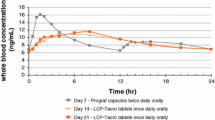Summary
Intestinal absorption of the microemulsion formulation of cyclosporin, Neoral®, unlike that of the conventional formulation, Sandimmun®, is relatively independent of factors such as the presence of bile acids, pancreatic enzymes and food. The consequent improvement in pharmacokinetic parameters, bioavailability and interindividual variability has particular advantages in liver transplantation.
The first situation in which Neoral® may have a significant advantage over Sandimmun® is immediately after liver transplantation, when oral administration (which is not possible with Sandimmun®) is desirable because i) intravenous administration of cyclosporin may lead to increased toxicity and ii) the switch from intravenous to oral administration may cause a fall in blood cyclosporin concentration, with the consequent risk of rejection. In 4 of the 5 series comparing Neoral® and Sandimmun® de novo after liver transplantation, a significant reduction of the rejection rate in favour of Neoral® was observed, without significant differences in nephrotoxicity or neurotoxicity.
The second situation in which Neoral® may have a particular advantage is in patients with impaired intestinal absorption, e.g. those with cystic fibrosis, in whom oral administration of Neoral® twice daily is usually successful. This finding may extend to other patients with limited cyclosporin absorption, such as young children and patients with cholestasis and gastroparesis.
The third situation to consider is conversion from Sandimmun® to Neoral® some time after transplantation, where the improved pharmacokinetics of Neoral® may lead to reduced rates of acute and chronic rejection and possibly to a reduction in adverse effects. In patients converted to Neoral® more than 6 months after transplantation, the improved bioavailability necessitated a dosage reduction of 15 to 20%, particularly in those patients who were receiving relatively high dosages of Sandimmun®, and the incidence of adverse effects was not increased.
Finally, there is the issue regarding discontinuation of corticosteroids in patients receiving Neoral® after liver transplantation. A pilot study has shown that this can be achieved more rapidly with Neoral® than with Sandimmun®.
Similar content being viewed by others
Références
Levy GA. Neoral therapy in liver transplantation. Transplant Proc 1996; 28: 2225–8
Jamieson NV, Tan L, Jamieson I, et al. Neoral in liver transplantation. Transplant Proc 1996; 28: 2229–31
Maboundou CW, Paintaud G, Bresson-Hadni S, et al. Effect of the transition from intravenous to oral dosing on cyclosporine-A trough concentration in liver transplantation. Ther Drug Monit 1996; 18: 310–4
Hoppu K, Jalanko H, Laine J, et al. Comparison of conventional oral cyclosporine and cyclosporine microemulsion formulations in children with a liver transplant. Transplantation 1996; 62: 66–71
Mueller EA, Kallay Z, Kovarik JM, et al. Bile-dependent absorption of cyclosporine from a microemulsion formulation in liver transplant patients. Transplantation 1995; 60: 515–7
Freeman D, Grant D, Levy G, et al. Pharmacokinetics of a new oral formulation of cyclosporine in liver transplant recipients. Ther Drug Monit 1995; 17: 213–6
Trull AK, Tan KKC, Tan L, et al. Absorption of cyclosporine from conventional and new microemulsion oral formulations in liver transplant recipients with external biliary diversion. Br J Clin Pharmacol 1995; 39: 627–33
Hemming AW, Greig PD, Cattral MS, et al. Microemulsion of cyclosporine without intravenous cyclosporine in liver transplantation. Transplantation 1996; 62: 1798–802
Haller GW, Winkler M, Bechstein WO, et al. Absorption of cyclosporine Neoral early after liver transplantation: is it possible to abandon intravenous cyclosporine A application? Transplant Proc 1996; 28: 2239–40
Winkler M, Haller G, Oldhafer K, et al. A new oral formulation of cyclosporine for early oral immunosuppressive therapy in liver transplant recipients. Transplantation 1996; 62: 1063–8
Pinson CW, Beauregard-Zollinger L, OLN 356 Principal Investigators. Interim analysis of study OLN-356: Neoral versus Sandimmune in US primary liver transplant recipients. Transplant Proc 1996; 28: 2234–6
Rasmussen A, Jortrup A, Hansen B, et al. Induction of immunosuppression by microemulsion cyclosporine in liver transplantation. Transplantation 1996; 62: 1031–3
Grant D, Rochon J, Levy G. Comparison of the long-term tolerability, pharmacodynamics and safety of Sandimmune and Neoral in liver transplant recipients. Ontario Liver Transplant Study Group. Transplant Proc 1996; 28: 2232–3
Mirza DF, Gunson BK, Soonawalla Z, et al. Reduced acute rejection after liver transplantation with Neoral-based triple immunosuppression. Lancet 1997; 349: 701–2
Mikhail GW, Eadon H, Rogers P, et al. Microemulsion formulation increases cyclosporine bioavailability in cystic fibrosis [letter]. Lancet 1995; 346: 1638–9
Van der Pijl JW, Srivastava N, Denouel J, et al. Pharmacokinetics of the conventional and microemulsion formulations of cyclosporine in pancreas-kidney transplant recipients with gastroparesis. Transplantation 1996; 62: 456–62
Pollard SG, Lodge JPA. Conversion from Sandimmune to Neoral in stable liver graft recipients. Transplant Proc 1996; 28: 2244–6
Author information
Authors and Affiliations
Rights and permissions
About this article
Cite this article
Calmus, Y. Néoral® en transplantation hépatique. BioDrugs 8 (Suppl 1), 15–18 (1997). https://doi.org/10.2165/00063030-199700081-00008
Published:
Issue Date:
DOI: https://doi.org/10.2165/00063030-199700081-00008




